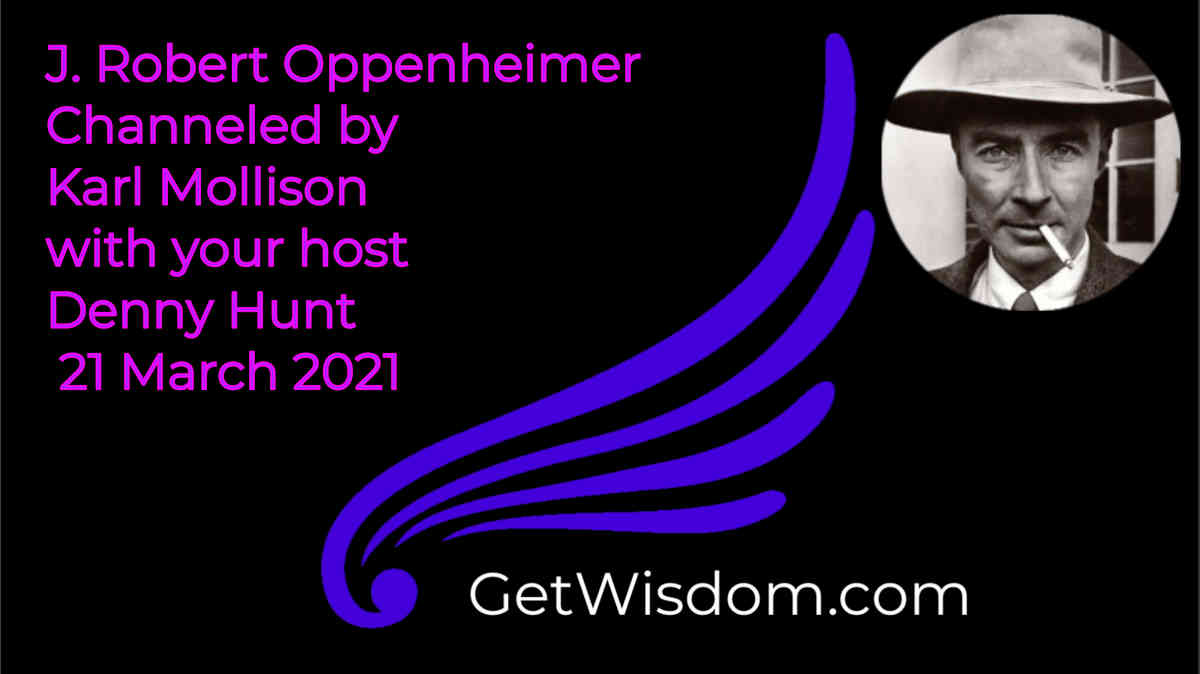
Robert Oppenheimer Channeled by Karl Mollison 18Apr2021
From https://en.wikipedia.org/wiki/J._Robert_Oppenheimer
Robert Oppenheimer April 22, 1904 – February 18, 1967
He was an American theoretical physicist and professor of physics at the University of California, Berkeley.
Oppenheimer was the wartime head of the Los Alamos Laboratory and is among those who are credited with being the “father of the atomic bomb” for their role in the Manhattan Project, the World War II undertaking that developed the first nuclear weapons.
The first atomic bomb was successfully detonated on July 16, 1945, in the Trinity test in New Mexico. Oppenheimer later remarked that it brought to mind words from the Bhagavad Gita: “Now I am become Death, the destroyer of worlds.”
In August 1945, the weapons were used in the atomic bombings of Hiroshima and Nagasaki.
After the war ended, Oppenheimer became chairman of the influential General Advisory Committee of the newly created United States Atomic Energy Commission. He used that position to lobby for international control of nuclear power to avert nuclear proliferation and a nuclear arms race with the Soviet Union.
He opposed the development of the hydrogen bomb during a 1949–50 governmental debate on the question and subsequently took stances on defense-related issues that provoked the ire of some factions in the U.S. government and military.
During the Second Red Scare, those stances, together with past associations Oppenheimer had with people and organizations affiliated with the Communist Party, led to him suffering the revocation of his security clearance in a much-written-about hearing in 1954. Effectively stripped of his direct political influence, he continued to lecture, write and work in physics. Nine years later, President John F. Kennedy awarded (and Lyndon B. Johnson presented) him with the Enrico Fermi Award as a gesture of political rehabilitation.
Oppenheimer’s achievements in physics included the Born–Oppenheimer approximation for molecular wave functions, work on the theory of electrons and positrons, the Oppenheimer–Phillips process in nuclear fusion, and the first prediction of quantum tunneling. With his students he also made important contributions to the modern theory of neutron stars and black holes, as well as to quantum mechanics, quantum field theory, and the interactions of cosmic rays. As a teacher and promoter of science, he is remembered as a founding father of the American school of theoretical physics that gained world prominence in the 1930s. After World War II, he became director of the Institute for Advanced Study in Princeton, New Jersey.
Oppenheimer was a chain smoker who was diagnosed with throat cancer in late 1965. After inconclusive surgery, he underwent unsuccessful radiation treatment and chemotherapy late in 1966. He fell into a coma on February 15, 1967, and died at his home in Princeton, New Jersey, on February 18, aged 62. A memorial service was held a week later at Alexander Hall on the campus of Princeton University. The service was attended by 600 of his scientific, political and military associates that included Bethe, Groves, Kennan, Lilienthal, Rabi, Smyth and Wigner.
His brother Frank and the rest of his family were also there, as was the historian Arthur M. Schlesinger, Jr., the novelist John O’Hara, and George Balanchine, the director of the New York City Ballet. Bethe, Kennan and Smyth gave brief eulogies.
Oppenheimer’s body was cremated and his ashes were placed into an urn. His wife Kitty took the ashes to St. John (U.S. Virgin Islands) and dropped the urn into the sea, within sight of the beach house.
In October 1972, Kitty died at age 62 from an intestinal infection that was complicated by a pulmonary embolism.
Oppenheimer’s ranch in New Mexico was then inherited by their son Peter, and the beach property was inherited by their daughter Katherine “Toni” Oppenheimer Silber. Toni was refused security clearance for her chosen vocation as a United Nations translator after the FBI brought up the old charges against her father. In January 1977 (three months after the end of her second marriage), she committed suicide at age 32; her ex-husband found her hanging from a beam in her family beach house. She left the property to “the people of St. John for a public park and recreation area”.
The original house was built too close to the coast and succumbed to a hurricane. Today the Virgin Islands Government maintains a Community Center in the area.
Could Oppenheimer’s work be public point of the spear for the longstanding Secret Space Program?
